Cite this document
(“Controversies Surrounding Pink Slime Essay Example | Topics and Well Written Essays - 1250 words”, n.d.)
Retrieved from https://studentshare.org/agriculture/1598965-controversies-surrounding-pink-slime
Retrieved from https://studentshare.org/agriculture/1598965-controversies-surrounding-pink-slime
(Controversies Surrounding Pink Slime Essay Example | Topics and Well Written Essays - 1250 Words)
https://studentshare.org/agriculture/1598965-controversies-surrounding-pink-slime.
https://studentshare.org/agriculture/1598965-controversies-surrounding-pink-slime.
“Controversies Surrounding Pink Slime Essay Example | Topics and Well Written Essays - 1250 Words”, n.d. https://studentshare.org/agriculture/1598965-controversies-surrounding-pink-slime.


